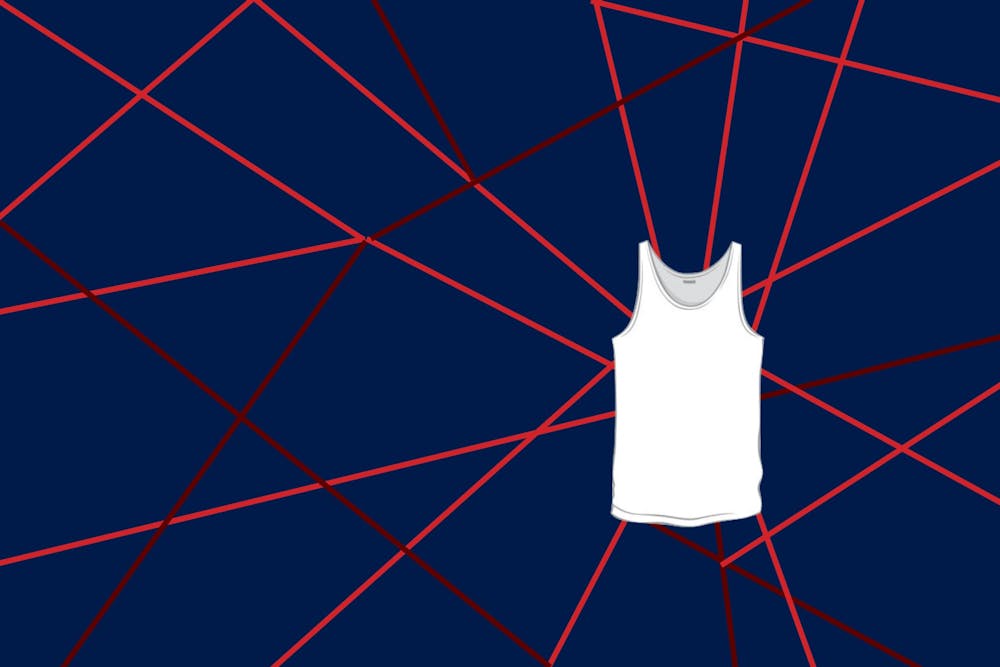Tank tops are undeniably a staple summer wardrobe piece. Easy to style and incredibly practical in the unbearable heat, it doesn't get more effortlessly cool and comfortable than a basic, monochrome cotton tank. But ironically, this simple classic has a darker, more complicated history that stretches beyond its recent incorporation into supermodels' street style or its presence in paparazzi pictures of buff male celebrities (take this photo of Mark Wahlberg, for example). For decades, this flimsy piece of fabric has carried the weight of a seemingly inescapable offensive nickname: the "wife beater.”
"Wife Beater:" Slang, Offensive. A sleeveless ribbed undershirt, typically white.
The term was coined in 1947. There are several theories as to how it surfaced—one is that it originated in the wake of a horrific crime that went viral. The crime was committed by a man named James Hartford Jr., who beat his wife to death. A picture of Hartford wearing a sleeveless white undershirt swept the nation, captioned “The Wife–Beater.”
Another theory is that Marlon Brando’s portrayal of Stanley Kowalski in A Streetcar Named Desire inspired the term. His character is violent, angry, and hits his wife—while wearing a sleeveless undershirt.
Regardless of the true origin of the term, white, sleeveless, ribbed tank tops took on the identity of a shirt worn by a beer–guzzling, Newport–smoking, pot bellied, abusive man. The term has since become far past antiquated, yet it's still prevalent in our vocabulary and at retail stores, many of which label tank tops by the term to this day. In fact, if you search "wife beaters" on Amazon, you'll get several options of men's tank tops to choose from.
However, the term “wife beater” did not obtain instant popularity upon its conception. In the mid–1900s, the tank top was referred to by various offensive terms, including “dago tee” and “guinea tee,” which were derogatorily associated with Italian immigrants.
Fast forward half a century later, and the term “wife beater” became commonplace in the 1990s and 2000s. Tank tops of this variety became more prominent during this time due to their low price tag and comfortable fit. What's more, iconic male celebrities, like rappers 50 Cent and Eminem, often sported the top, further popularizing the trend and contributing to its intimidating and cool reputation.
An article titled “An Undershirt Named … What?” published in 2001 quoted Jesse Sheidlower, the principal editor of the Oxford English Dictionary’s American office at the time. Sheidlower attributes the term’s growing popularity in part to "rap, gay and gang subcultures."
The term and its implications are inappropriate and offensive, and should be abandoned for countless reasons—one being that sleeveless ribbed tank tops of this variety have taken on a whole new identity as of late.
Sleeveless tank tops are the casual dresser's bread and butter—comfortable, practical, and generally inexpensive. They can be dressed up or dressed down, and sported for any occasion that permits an exposed shoulder. But in the years that have passed since the term “wife beater” was coined, the tank top has evolved into an article of clothing more and more infrequently worn by men.
As of 2021, sleeveless ribbed tank tops are far more often sported by young women. Look at almost any popular clothing brand—Zara, Brandy Melville, H&M—and you’ll see tank tops of this variety, marketed specifically for women.
It's safe to say that over the years this basic tee has actually, in an interesting turn of events, become more of a staple in the female wardrobe than the male. It's almost like a feminist rebranding, women co–opting the look to also work for themselves and making it more unisex than solely masculine.
As we reckon with the past and look to the future, it is important for our generation to think more about our words and the power they hold—even if we're describing something inanimate. The term “wife beater” is a colloquial reference that is now frowned upon by many, but it still remains part of our vernacular, a term still mindlessly used—albeit probably more infrequently today than in the past. Nonetheless, it's time to hang it up to dry.

